Sustainable Design with Holland Harvey: Audio Interview
Welcome to our first Audio Interview! Design Insider Editor, Alys Bryan, visited architects Holland Harvey in their East London studio after hearing Richard Holland speak passionately about the teams sustainable approach to their projects at the Workspace Design Show. Alys discussed their recent Inhabit project with Richard and Holland Harvey Co-Founder Jonathan Harvey and they are joined by Marie Carlisle, Co-Founder of social enterprise Goldfinger.
Listen to our conversation by clicking below or scroll down to read more.
Alys Bryan (AB): Richard, I heard you speak passionately at the Workspace Design Show about the ways in which Holland Harvey Architects instil sustainability at the heart of many of your projects. Could you begin by introducing yourself and your studio?
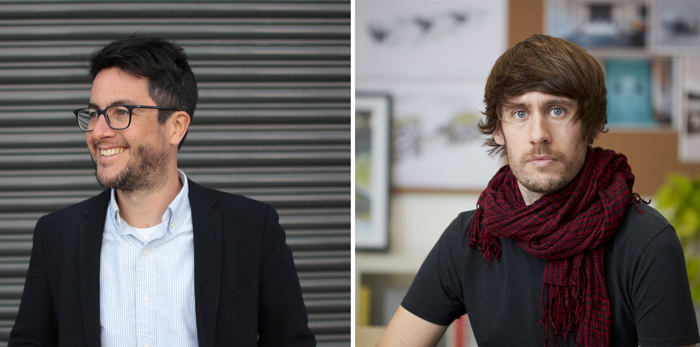
Holland Harvey Co-Founders Richard Holland and Jonathan Harvey
Richard Holland (RH): We are Holland Harvey. We are based here in Bethnal Green. We’re a team of 22 people and growing. We’re 10 years old next year, which is rather insane!
We’re an architecture studio focused on hospitality as well as homes; everyone would like their house to feel like a hotel, hotels want to be the home away from home, and that’s the work that we enjoy. Our work is predominantly in London, but increasingly further afield, we’re actually doing quite a lot of work overseas at the moment.
Jonathan Harvey (JH): The whole studio was born out of an organization called Free Architecture, which focused on giving 1% of your time to third sector organizations, we tried to set up in 2012. This organization never quite got rolling but Holland Harvey was born and at the heart of our studio is social value.
RH: When we started the practice, we were doing smaller projects. We were lucky enough to get to work with Gail’s Bakery, who we still work with to this day, and this is when we first started working with Goldfinger.
AB: Marie, perhaps you can tell us a little bit more about yourself and the work you do for Goldfinger?
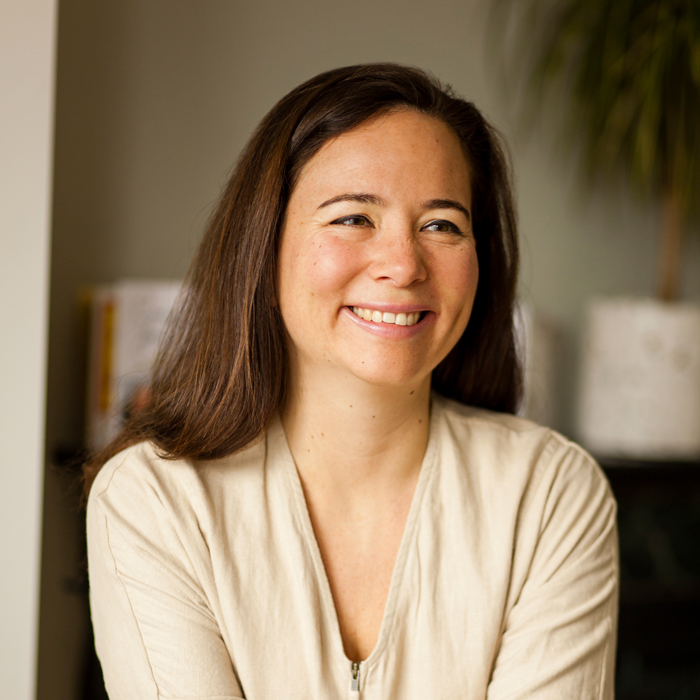
Goldfinger Co-Founder Marie Carlisle
Marie Carlisle (MC): I’m the CEO and Co-Founder of Goldfinger. We’re a design-led social enterprise, making sustainable furniture from low carbon materials for homes and businesses. We reinvest all of our profits back into our local community. We’ve just celebrated our eighth anniversary. Although our mission, ethics and purpose has always been clear, the way in which we deliver it has definitely evolved.
Our charitable initiatives at Goldfinger include our educational platform where we share our skills in traditional craftsmanship and sustainable design with people of all ages and backgrounds, ranging from 10 year old school children to elderly vulnerable people from our community. We also run a soup kitchen through our onsite restaurant, where we sit down with our local community once a month for a delicious meal cooked from surplus ingredients. Since the pandemic hit, we’ve been running this as a meal delivery service for vulnerable residents in the local community.
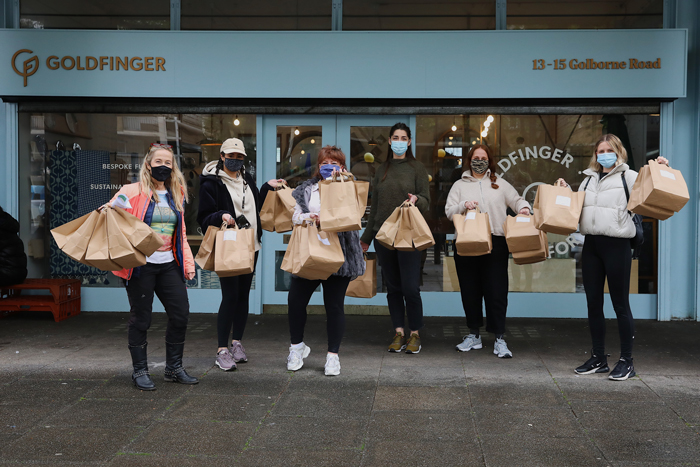
We provide a very unusual mix of furniture making, teaching, and delivering meals: we put food on the table, we make the table, we teach people how to make the table, and we sell the table!
My background is in the luxury goods industry. I’m half French, half Chinese, and I grew up in Hong Kong. Living in Hong Kong very much informed my sustainability journey as I was faced with omnipresent high levels of pollution and waste. I remember a moment when I was 8 years old and seeing a fridge floating in the ocean and thinking “something’s not right here” and it was so obvious that we humans are causing damage to our beautiful planet. It was such a graphic image which has stayed with me through my career in the luxury goods industry. I came to realise that beauty without sustainability felt pointless and somehow diminished its beauty for me.
AB: It’s amazing to hear how all of those aspects of the enterprise all come together. Richard and Jonathan, sustainability is at the heart of many of your projects. Has that always been something that you’ve passionate about?
RH: I think it’s evolved as the practice has matured. When you’re a younger practice you are trying to make ends meet. Then, you get to quite a fortunate position where we can establish your values. Very much one of our values that’s evolved over the last five years is our sustainability agenda. It’s not something we put at the front of our brand because it’s a given in the work that we do.
We believe in a fabric-first approach to environmentally conscious design. For us it’s about asking about the details of the product, it’s a research and development process that happens in the studio when we’re talking to suppliers, craftspeople, and makers, et cetera.
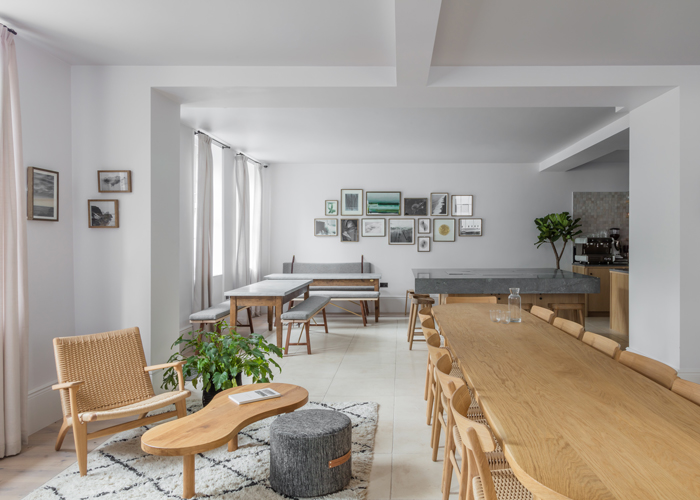
Inhabit ©Nicholas Worley
One of the brands we work with is a hotel chain called Inhabit. Sustainability is very much at the front of the chain’s agenda and they give us the capacity to undertake product and material research. There’s a risk involved with new materials and products as they’re very new to market. Inhabit has allowed us space to explore new ideas, materials and products and that’s why there was a great opportunity to introduce Goldfinger to this client. As a result, we’ve developed a furniture range, which is now a product that Goldfinger are bringing to market. You can sit at this beautiful table in a socially and environmentally conscious hotel, and you can buy the same table for your home.
JH: Inhabit being so forward thinking and open to trying new products has enabled our practice to change over the last five years. The sustainability conversation was always there in our studio, but a lot of the time the client didn’t see the value in it because often it was more expensive. Now, bigger manufacturers are getting behind sustainability which gives us the ability to specify products which align with our sustainability standards.
Client conversations are still necessary when considering materials which impact budget and although clients are starting to be more open to these conversations it always returns to cost.
MC: If a client is the one willing to invest in sustainable design, it allows for experimentation. Thankfully, there are brave and risk-taking clients like Inhabit who are willing to invest in reaching their sustainability standards.
RH: These clients are driven by their consumers. If someone would prefer to stay in a sustainable hotel rather than a standard run-of-the-mill non-sustainable hotel brand, then they vote with their pound, and that client is going to see the value of further investing in their sustainable approach.
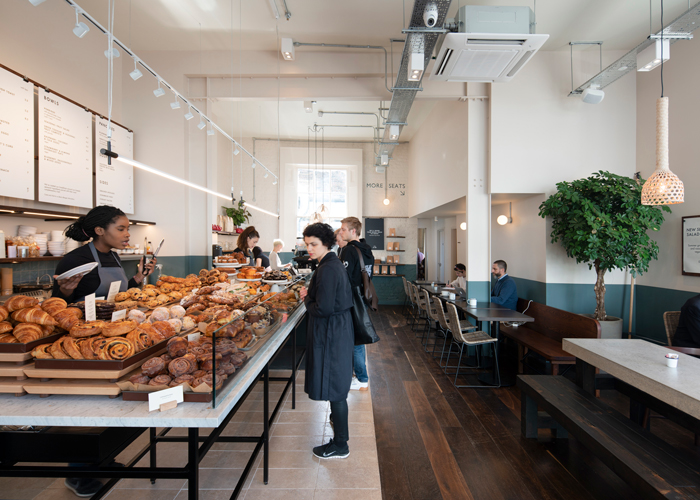
Gails Bakery, Kentish Town
AB: It’s wonderful to hear that each individual person’s choices eventually build up to have an impact. It’s also wonderful to hear that furniture and product material suppliers are launching the types of products that meet the standards that you want to achieve for your projects. When you are looking for those suppliers, what specifications are you looking for?
RH: The Workspace Show, was a great opportunity to talk very openly. You could ask manufacturers directly about the credentials of their products. I met amazing people who were doing things that I couldn’t have even dreamed of. Carpet suppliers making carpet out of old fishing nets and recycled bottles. Then, once that carpet is done, the contractor can peel it away to see a label on the back with a phone number, they call the number and the supplier will come and pick up the carpet. They’ll take it back to their factory, separate into their component parts, run it through their machine, turn it into new carpet, sell it to someone else. You’re just like, “Wow, there is an infrastructure around this!”
There are certain certifications like Cradle-to-Cradle and within the architecture industry, there’s BREEAM, and WELL, within hospitality there’s Green Key. There isn’t one capsule certification, but I’m sure there’s some that will come.
MC: This is a really interesting segue to some of the sourcing issues that we find with certification. People ask how sustainable the timber is that we use but there are different grades of timber. We use British woods in native species, as well as reclaimed woods. The reclaimed wood genuinely had another life as a piece of furniture before it came to us through a network of partners including construction companies, and retailers like Harvey Nichols who donated Cedar from their Christmas windows in 2019.
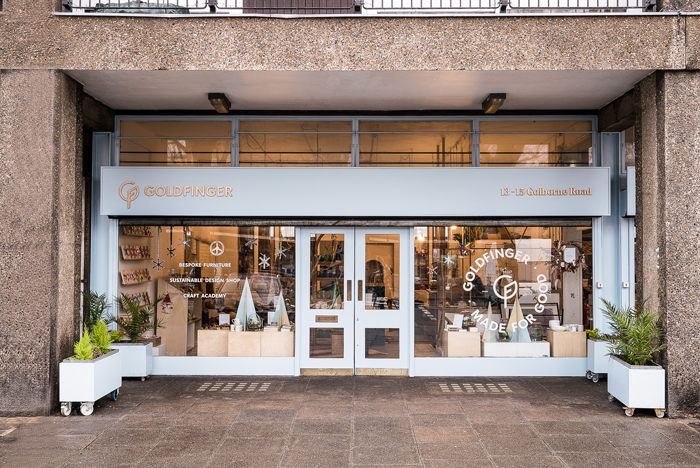
Imperial College donated teak desks that they had used since the 1950s which was particularly interesting for us because teak isn’t a wood that we would normally work with, very much not local, very much not sustainable. To use this reclaimed timber is a really interesting example of how sustainability is also about provenance. It is 10 times more carbon efficient to use reclaimed wood.
In the past when we have used virgin timber, we have used FSC certificated timber which ensures that we’re using it from the most renewable, well-managed forests. Nevertheless, it’s still cutting down new trees.
Over the last two to three years, we’ve been developing new networks and partners and have identified a new source of wood from fallen trees. There’s a huge amount of trees that fall down because of storms, or are felled because of disease, or for urban development. In London alone, approximately 5,000 trees are cut down each year. We’ve started to connect tree surgeons with timber merchants who have kilns required for seasoning the wood. We’re now able to almost exclusively use fallen tree wood, working with timber merchants, suppliers, and tree surgeons. In the last two weeks we’ve had over 100 trees donated that fell during a storm.
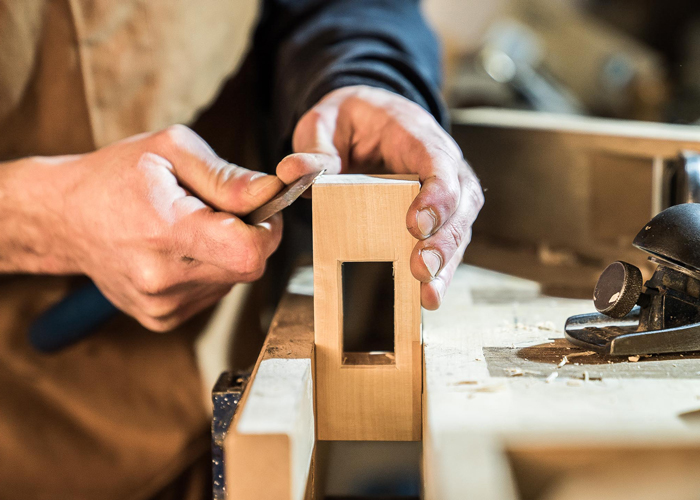
What is interesting is that this timber doesn’t have any certification at the moment, although it’s infinitely more sustainable than FSC.
Another interesting certification is B Corp, which is a real badge of approval and is very hard to get. What’s really great about it is it’s global. Inhabit Hotel is a B Corp. I think we’re going to be hearing a lot more about it because it is the only global accreditation.
AB: Certainly, are you doing research into that?
RH: It’s an aspiration for our studio, but as you say, there’s a lot of work to be done. One thing I like about B Corp is that it gives you an inherent network. The value would be that we would be a B Corp architect working for a B Corp hotelier with a B Corp supply chain.
AB: The furniture collection that you worked on together with Goldfinger, was that for the Inhabit Hotels brand?
RH: Yes. The table collection came about whilst we were working together on Inhabit. We’re now doing the second hotel for them, which opens in the new year in Paddington, which includes many of the same pieces.
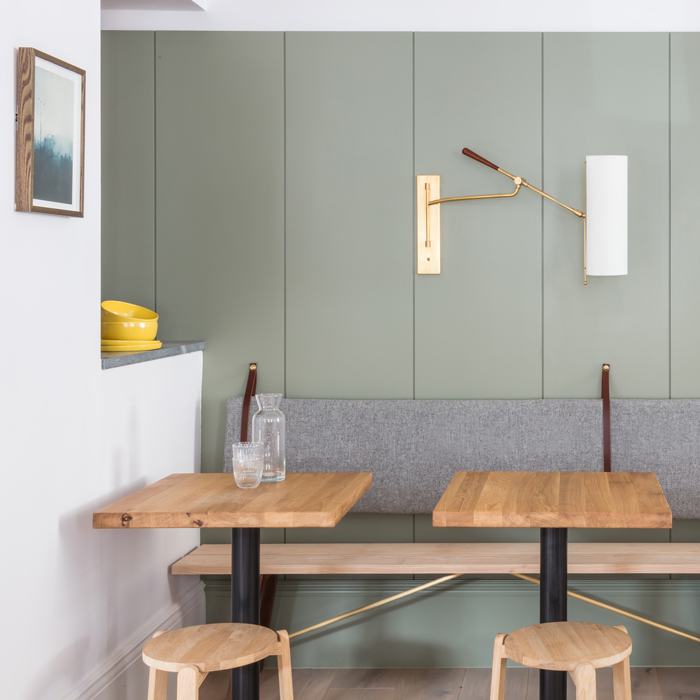
Inhabit ©Nicholas Worley
For the first hotel we designed many pieces of beautiful furniture and Goldfinger spent a lot of time finessing it and making it. We made a handful of the items and installed them in the hotel which was very well received. Then we felt that this couldn’t mark the end for the furniture designs and I discussed with Marie the feasibility of making the tables a retail product. Our client very kindly agreed and it has been branded the Inhabit range, designed by Holland Harvey and made by Goldfinger. We expanded the collection whilst we worked on the second hotel and look forward to adding further designs when we work on future hotels for the chain. Their guests can stay in the hotel and buy the table they admire for their home whilst supporting an amazing social enterprise. It kind of all made sense.
AB: How does that work with reclaimed timber? Does the design accommodate any timber type or have you a sufficient supply of timber that collection can be made consistently in a specific timber?
MC: They were made in oak for the hotel. When we launched the collection we thought it would be nice to offer the pieces in several different woods, and so they’re available in Ash, Oak, and Walnut which we’re able to source locally in the UK. We have a plentiful supply of Ash because of Ash Dieback.
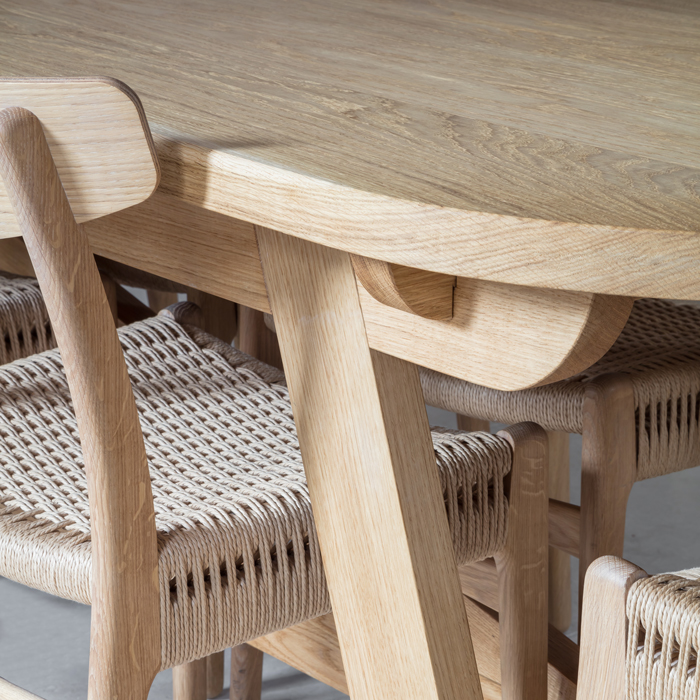
Inhabit ©Nicholas Worley
AB: It’s your own craftspeople that make the furniture? Where do those people come from and who trains them?
MC: The full-time team are extremely skilled and come to us as masters. The apprentices are young people from the community who often have no existing skills. We are relaunching our apprenticeship to be focused on object-making including chopping boards, coasters, bowls.

JH: It’s all about role models. The apprentices work in an environment with people they have respect for and look up to because sometimes they don’t have that in their home life. The apprentices see the value of learning a trade, becoming an expert, something that you can see is very accessible to you because it’s about skills, which you’re learning already. I think being in a professional environment is ideal.
AB: Richard and Jon, what does the future hold for the sustainable standards at Holland and Harvey?
RH: We’ve identified key goals that we intend to focus on every 90 days. Our sustainability agenda is something that we want to commit more time to. Projects like Inhabit have given us an opportunity to gain a huge amount of knowledge and expertise and now we need to take that and make sure that everyone in the company is fully informed about our core network of people and suppliers.
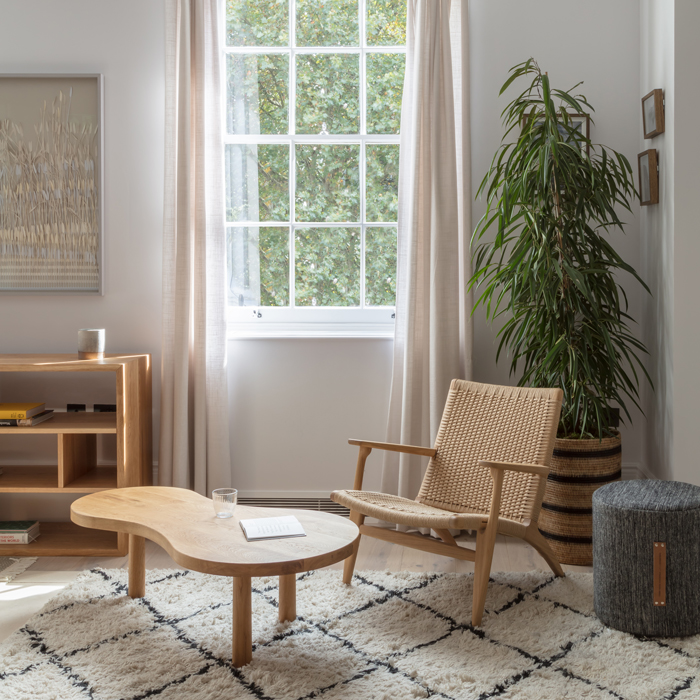
Inhabit ©Nicholas Worley
JH: We’ve identified that there are key things in the studio that we need champions for, historically they would be things like CAD and IT development, health and safety, and quality management. We’ve now created a sustainability champion. That person’s role is to curate the full team’s sustainable contacts into one library. We already have a weekly CPD program and the new sustainability champion will be responsible for organizing a monthly sustainable CPD. We will be constantly growing our knowledge and we need to bring people externally to help us grow that knowledge.
RH: There’s already some useful tools available. We’re a RIBA Chartered Practice and RIBA has a brief tracker where you can record your sustainability targets for that project and at every point refer back to that initial document to confirm that you are delivering on those aspirations. It enables us to be really rigorous and have accountability in the studio to make sure the aspirations are followed through all the way.
AB: Marie, what can we look forward to seeing from Goldfinger in the near future?
MC: We have several new exciting furniture collections in development which we’re excited to share with the world, alongside working on bespoke commissions. We will be working increasingly with timber sourced from locally-grown trees that have been felled due to weather-related incidents, disease or urban development, and asking people to get in touch with us if they have a fallen tree that could be given new life. In the second half of 2022, we will be launching several new Inhabit x Goldfinger pieces in the second half of 2022, so watch this space!
AB: I very much look forward to seeing those. Thank you all so much for your time and your knowledge today, and for meeting me on such a dark, rainy day. Thank you so much.





Comments